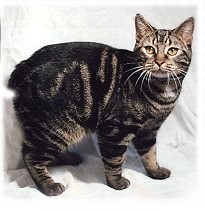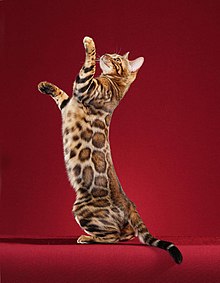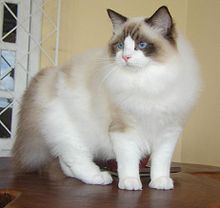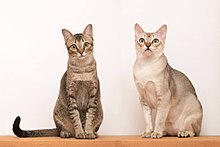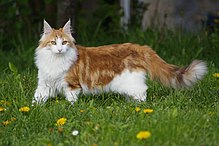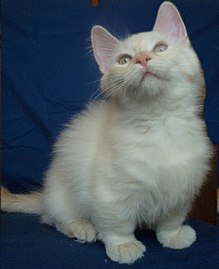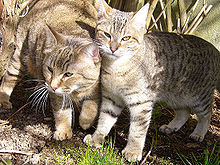Portal:Cats/Selected breed
Selected breed 1
The Maine Coon is a large domesticated cat breed. It is one of the oldest natural breeds in North America. The breed originated in the U.S. state of Maine, where it is the official state cat.
The Maine Coon is a large and social cat, which could be the reason why it has a reputation of being referred to as "the gentle giant." The Maine Coon is predominantly known for its size and dense coat of fur which helps it survive in the harsh climate of Maine. The Maine Coon is often cited as having "dog-like" characteristics.
Selected breed 2
The Siamese cat (Thai: แมวไทย, Maeo Thai; แมวสยาม, Maeo Sayam) is one of the first distinctly recognised breeds of Asian cat. Derived from the Wichianmat landrace, one of several varieties of cats native to Thailand (formerly known as Siam), the original Siamese became one of the most popular breeds in Europe and North America in the 19th century. Siamese cats have a distinctive colourpoint coat, resulting from a temperature-sensitive type of albinism.
The carefully refined, more extreme-featured, modern-style Siamese is characterised by blue almond-shaped eyes; a triangular head shape; large ears; an elongated, slender, and muscular body; and various forms of point colouration. Other than point colouration, the modern-style Siamese bears little resemblance to the original foundation stock, and the more moderate, traditional, or "old-style" Siamese, with a much rounder head and body, has been re-established by multiple registries as the Thai cat. Both Siamese and Thai cats are separately selectively bred by breeders, and pedigreed in multiple major cat fancier and breeder organisations. Similar to other officially recognised cat breeds, the term "Siamese" or "Thai" is only meant to be used for cats from this specific breed, which are by definition all purebred cats with a known and formally registered ancestry, also known as the cat's pedigree or "paperwork".
Selected breed 3
The Manx cat (/ˈmæŋks/, in earlier times often spelled Manks) is a breed of domestic cat (Felis catus) originating on the Isle of Man, with a mutation that shortens the tail. Many Manx have a small stub of a tail, but Manx cats are best known as being entirely tailless; this is the most distinguishing characteristic of the breed, along with elongated hind legs and a rounded head. Manx cats come in all coat colours and patterns, though all-white specimens are rare, and the coat range of the original stock was more limited. Long-haired variants are sometimes considered a separate breed, the Cymric.
Manx are prized as skilled hunters, and thus have often been sought by farmers with rodent problems, and been a preferred ship's cat breed. They are said to be social, tame and active. An old local term for the cats on their home island is stubbin or rumpy. Manx have been exhibited in cat shows since the 1800s, with the first known breed standard published in 1903.
Selected breed 4
The British Shorthair is the pedigreed version of the traditional British domestic cat, with a distinctively stocky body, thick coat, and broad face. The most familiar colour variant is the "British Blue", with a solid grey-blue coat, pineapple eyes, and a medium-sized tail. The breed has also been developed in a wide range of other colours and patterns, including tabby and colourpoint.
It is one of the most ancient cat breeds known. In modern times, it remains the most popular pedigreed breed in its native country, as registered by the UK's Governing Council of the Cat Fancy (GCCF). A quarter of all kittens registered with the GCCF each year are British Shorthairs, making the British the most popular pedigree cat in the UK.
Selected breed 5
The Siberian is a centuries-old landrace (natural variety) of domestic cat in Russia, and recently developed as a formal breed with standards promulgated the world over since the late-1980s. Since 2006, the breed is recognised for registry and championship status with all major cat registries.
The formal name of the breed is Siberian Forest Cat, but it is typically referred to as the Siberian or Siberian cat. Formerly, sometimes the names Moscow Semi-Longhair and Russian Longhair were also used. The colourpoint variant or sister breed, called the Neva Masquerade, is categorised as a separate cat breed by some registries, including FIFe, WCF and ACF.
Selected breed 6
The Turkish Van is a semi-long-haired, standardised breed of domestic cat, which was developed in the United Kingdom from a selection of cats obtained from various cities of modern Turkey, especially southeast Turkey. The breed is rare, is one of the larger breeds, and is distinguished by the Van pattern (named after the breed), where the colour is restricted to the head and the tail, and the rest of the cat is white; this is due to the expression of the piebald white spotting gene, a type of partial leucism. A Turkish Van may have blue or amber eyes, or be odd-eyed (having one eye of each colour).
The breed was first recognised as such by a breeder/fancier organisation, the UK-based Governing Council of the Cat Fancy (GCCF), in 1969, under the name Turkish cat. It was later renamed Turkish Van to better distinguish it from the Turkish Angora breed. The Turkish Van has been claimed to be descended from (and is often confused with) the landrace of usually all-white Van cats, mostly found near Lake Van, though one of the two original breeders' own writings indicate clearly that none of the breed's foundation cats came from the Van area.
Selected breed 7
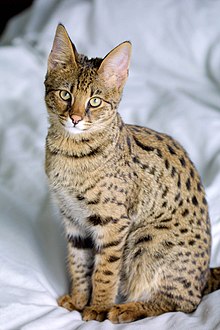
The Savannah is a breed of hybrid cat developed in the late 20th century from crossing a serval (Leptailurus serval) with a domestic cat (Felis catus). This hybridization typically produces large and lean offspring, with the serval's characteristic large ears and markedly brown-spotted coats. F1 and F2 male Savannahs can be very large, and in 2016 an F2 male attained a world record for tallest cat at 48.4 centimetres (19.1 in). Show-eligible F4–F5 cats range from 5.0 to 8.2 kilograms (11.0 to 18.1 lb) however, comparable in size to other large domestic cat breeds such as the Maine Coon or Norwegian Forest cat. The Savannah cat is the largest of the cat breeds. A Savannah cat is a cross between a domestic cat and a serval, a medium-sized, large-eared wild African cat. The unusual cross became popular among breeders at the end of the 1990s, and in 2001 The International Cat Association (TICA) accepted it as a new registered breed. In May 2012, TICA accepted it as a championship breed.
Selected breed 8
The Bengal cat is a breed of hybrid cat created from crossing of an Asian leopard cat (Prionailurus bengalensis), with domestic cats, especially the spotted Egyptian Mau. It is then usually bred with a breed that demonstrates a friendlier personality, because after breeding a domesticated cat with a wildcat, its friendly personality may not manifest in the kitten. The breed's name derives from the leopard cat's taxonomic name.
Bengals have a wild appearance; their golden shimmer comes from their leopard cat ancestry, and their coats may show spots, rosettes, arrowhead markings, or marbling. They are an energetic breed that needs much exercise and play.
Selected breed 9
The Ragdoll is a breed of cat with a distinct colorpoint coat and blue eyes. Its morphology is large and weighty, and it has a semi-long and silky soft coat. American breeder Ann Baker developed Ragdolls in the 1960s. They are best known for their docile, placid temperament and affectionate nature. The name 'Ragdoll' is derived from the tendency of individuals from the original breeding stock to go limp and relaxed when picked up. The breed is particularly popular in both the United Kingdom and the United States.
Ragdolls are often known as "dog-like cats" or "puppy-like cats", due to their tendency to follow people around, their receptiveness to handling, and their relative lack of aggression towards other pets.
Selected breed 10
The Singapura is the smallest breed of cat, noted for its large eyes and ears, ticked coat, and blunt tail. Reportedly established from three "drain cats" imported from Singapore in the 1970s, it was later revealed that the cats were originally sent to Singapore from the United States before being exported back to the US. Investigations by the Cat Fanciers' Association (CFA) concluded that no wrongdoing had occurred and the Singapura kept its status as a natural breed.
Selected breed 11
The Balinese is a long-haired breed of domestic cat with Siamese-style point coloration and sapphire-blue eyes. The Balinese is also known as the purebred long-haired Siamese since it originated as a natural mutation of that breed and hence is essentially the same cat but with a medium-length silky coat and a distinctively plumed tail.
As is the case with their short-haired counterparts, a genetic distinction is made between traditional or "old-style" and modern body types. In the American standard, color variants derived from the Colorpoint Shorthair are further considered a separate breed, known as the Javanese. There is no particular connection between these cats and the Indonesian islands of Bali and Java, from which they derive their names.
Selected breed 12
The Norwegian Forest cat (Norwegian: Norsk skogkatt and Norsk skaukatt) is a breed of domestic cat originating in Northern Europe. This landrace breed is adapted to a very cold climate, with a top coat of long, glossy hair and a woolly undercoat for insulation. The breed's ancestors may have been a landrace breed of short-haired cats brought to Norway about A.D. 1000 by the Vikings, who may also have brought with them long-haired cats, like those ancestral to the modern Siberian and Turkish Angora.
During World War II, the Norwegian Forest cat was nearly extinct; then the Norwegian Forest Cat Club's breeding program increased the cat's number. It was registered as a breed with the European Fédération Internationale Féline in the 1970s, when a cat fancier, Carl-Fredrik Nordane, took notice of the breed and made efforts to register it. The breed is very popular in Norway, Denmark, Sweden, Iceland, and France.
Selected breed 13

The Sphynx cat (pronounced SFINKS, /ˈsfɪŋks/) also known as the Canadian Sphynx, is a breed of cat known for its lack of fur. Hairlessness in cats is a naturally occurring genetic mutation, and the Sphynx was developed through selective breeding of these animals, starting in the 1960s.
The skin has a texture of chamois leather, as it has fine hairs, or the cat may be completely hairless. Whiskers may be present, either whole or broken, or may be totally absent. Per the breed standards, they have a somewhat wedge-shaped head with large eyes and ears, quite long legs and tail, and neat rounded paws. Their skin is the color that their fur would be, and all the usual cat markings (solid, point, van, tabby, tortie, etc.) may be found on the Sphynx cat's skin. Because they have no fur, Sphynx cats lose body heat more readily than coated cats, making them both warm to the touch and prone to seeking out warm places.
Selected breed 14
The Scottish Fold is a distinctive breed of domestic cat characterised by a natural dominant gene mutation associated with osteochondrodysplasia. This genetic anomaly affects cartilage throughout the body, causing the ears to "fold", bending forward and down towards the front of the head. While this trait contributes to the breed's unique appearance, often described as "owl-like", it has negative effects on the cats' welfare.
Originally called lop-eared or lops after the lop-eared rabbit, Scottish Fold became the breed's name in 1966. Depending on registries, longhaired Scottish Folds are varyingly known as Highland Fold, Scottish Fold Longhair, Longhair Fold and Coupari.
Selected breed 15
The Persian cat, also known as the Persian Longhair, is a long-haired breed of cat characterised by a round face and short muzzle. The first documented ancestors of Persian cats might have been imported into Italy from Khorasan as early as around 1620, however, this has not been proven. Instead, there is stronger evidence for a longhaired cat breed being exported from Afghanistan and Iran from the 19th century onwards. Widely recognised by the North-West European cat fancy since the 19th century, and after World War II by breeders from North America, Australia and New Zealand. Some cat fancier organisations' breed standards subsume the Himalayan and Exotic Shorthair as variants of this breed, while others generally treat them as separate breeds.
The selective breeding carried out by breeders has allowed the development of a wide variety of coat colours, but has also led to the creation of increasingly flat-faced Persian cats. Favoured by fanciers, this head structure can bring with it several health problems. As is the case with the Siamese breed, there have been efforts by some breeders to preserve the older type of cat, the Traditional Persian, which has a more pronounced muzzle. Hereditary polycystic kidney disease (PKD) is prevalent in the breed, affecting almost half of the population in some countries.
Selected breed 16
The Munchkin is a breed of cat characterized by its very short legs, which are caused by genetic mutation. Compared to many other cat breeds, it is a relatively new breed, documented since 1940s and officially recognized in 1991. The Munchkin is considered to be the original breed of dwarf cat.
Much controversy erupted over the breed when it was recognized by The International Cat Association (TICA) in 1997 with critics voicing concerns over potential health and mobility issues. Many pedigree cat associations around the world have refused to recognize the Munchkin cat due to the welfare of the breed and uncertainty of the health issues, including the Governing Council of the Cat Fancy (GCCF). Breeding of Munchkin cats is prohibited by law in several countries due to these genetic health concerns.
Selected breed 17
The Pixie-bob is a breed of domestic cat claimed to be the progeny of naturally occurring bobcat hybrids. However, DNA testing has failed to detect bobcat marker genes, and Pixie-bobs are considered wholly domestic for the purposes of ownership, cat fancy registration, and import and export. They were, however, selected and bred to look like American bobcats.
Selected breed 18

The Cymric (/ˈkɪmrɪk/ KIM-rik, /ˈkʌmrɪk/ KUM-rik) is a Canadian cat breed. Some cat registries consider the Cymric a semi-long-haired variety of the Manx breed, rather than a separate breed. Except for the length of fur, in all other respects, the two varieties are the same, and kittens of either sort may appear in the same litter. The name comes from Cymru (Welsh pronunciation: [ˈkəmrɨ]), the indigenous Welsh name of Wales, even though the breed is not associated with Wales. The name may have been chosen to provide a "Celtic" sounding moniker for the breed. While the breed's Manx bloodline originated from the Isle of Man, the long-haired variant is claimed to have been developed by Canada. The breed is called the Longhair Manx or a similar name by some registries.
Selected breed 19

The Snowshoe is a rare breed of domestic cat originating in the United States of America in the 1960s. The Snowshoe is a short-haired bicolour colourpoint breed. Snowshoes were first produced when a Siamese breeder's cat gave birth to three kittens with white feet. The breeder, Dorothy Hinds-Daugherty, then began a breeding program to produce what were originally called "Silver Laces", crossing the strangely marked Siamese cats with bicolour American Shorthair cats and other breeds. Despite having existed for 45 years, Snowshoes are rare due to the difficulty of reproducing the correct coat markings.
Selected breed 20
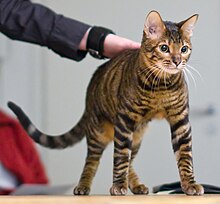
The toyger is a breed of domestic cat, the result of breeding domestic shorthaired tabbies (beginning in the 1980s) to make them resemble a "toy tiger", as its striped coat is reminiscent of the tiger's. The breed's creator, Judy Sugden, has stated that the breed was developed in order to inspire people to care about the conservation of tigers in the wild. It was recognized for "registration only" by The International Cat Association in the early 2000s, and advanced through all requirements to be accepted as a full championship breed in 2012. There are about 20 breeders in the United States and another 15 or so in the rest of the world,
In 2020, 469 toygers are registered on the Pawpeds Database.
Usage[edit]
The layout design for these subpages is at Portal:Cats/Selected breed/Layout.
- Add a new selected breed to the next available subpage.
- Update "max=" to new total for its {{Random portal component}} on the main page.



